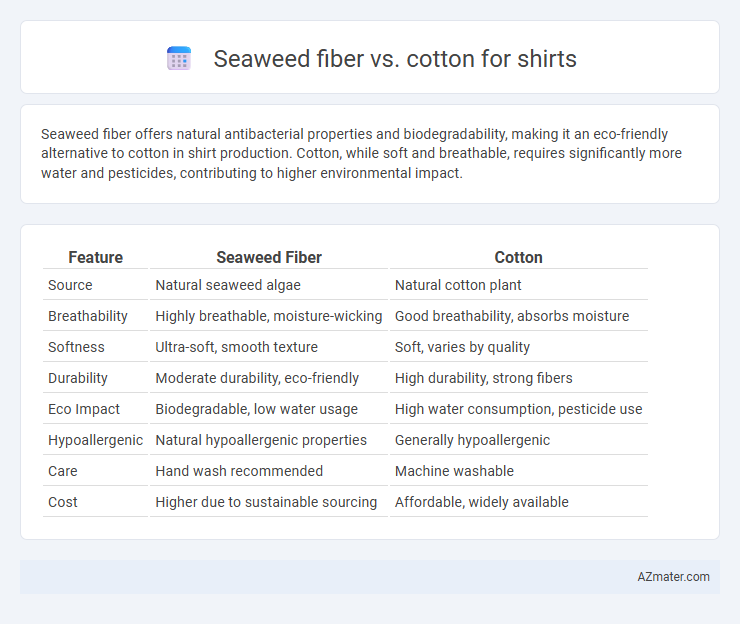Seaweed fiber offers natural antibacterial properties and biodegradability, making it an eco-friendly alternative to cotton in shirt production. Cotton, while soft and breathable, requires significantly more water and pesticides, contributing to higher environmental impact.
Table of Comparison
| Feature | Seaweed Fiber | Cotton |
|---|---|---|
| Source | Natural seaweed algae | Natural cotton plant |
| Breathability | Highly breathable, moisture-wicking | Good breathability, absorbs moisture |
| Softness | Ultra-soft, smooth texture | Soft, varies by quality |
| Durability | Moderate durability, eco-friendly | High durability, strong fibers |
| Eco Impact | Biodegradable, low water usage | High water consumption, pesticide use |
| Hypoallergenic | Natural hypoallergenic properties | Generally hypoallergenic |
| Care | Hand wash recommended | Machine washable |
| Cost | Higher due to sustainable sourcing | Affordable, widely available |
Introduction to Seaweed Fiber and Cotton
Seaweed fiber, derived from sustainably harvested marine algae, offers a biodegradable and eco-friendly alternative to traditional textiles with natural antibacterial properties and moisture-wicking capabilities. Cotton, a widely used natural fiber sourced from the cotton plant, is renowned for its softness, breathability, and durability but often requires significant water and pesticide use during cultivation. Comparing their environmental impacts and performance highlights seaweed fiber's potential for sustainable fashion alongside cotton's established role in comfortable everyday wear.
Environmental Impact Comparison
Seaweed fiber production generates significantly lower water consumption and greenhouse gas emissions compared to conventional cotton farming, with a 95% reduction in water use per kilogram of fiber. Seaweed cultivation requires no pesticides or fertilizers, drastically reducing chemical runoff and soil degradation commonly associated with cotton agriculture. This sustainable alternative also supports marine ecosystems by promoting biodiversity, whereas cotton farming often leads to habitat loss and extensive soil erosion.
Sustainability and Resource Use
Seaweed fiber shirts require significantly less water and land compared to cotton, making them a more sustainable textile choice. Seaweed cultivation supports marine ecosystems by absorbing carbon dioxide and releasing oxygen, while cotton farming often leads to soil degradation and high pesticide use. Choosing seaweed fiber reduces environmental impact through renewable resource use and biodegradability, positioning it as an eco-friendly alternative to traditionally resource-intensive cotton.
Comfort and Breathability
Seaweed fiber shirts offer superior breathability due to their natural moisture-wicking properties, keeping the skin dry and comfortable throughout the day. Cotton fabric, known for its softness and absorbency, provides a gentle touch on the skin but may retain moisture, potentially reducing comfort in hot or humid conditions. Seaweed fiber's lightweight structure enhances air circulation, making it an excellent choice for breathable, comfortable shirts in warm climates.
Durability and Longevity
Seaweed fiber shirts exhibit superior durability due to their natural elasticity and resistance to wear, outperforming conventional cotton in longevity. Cotton fibers tend to weaken and degrade faster after repeated washes, while seaweed fabric maintains structural integrity and color retention over time. This makes seaweed fiber an eco-friendly and durable alternative for long-lasting apparel, reducing the need for frequent replacements.
Skin Sensitivity and Hypoallergenic Properties
Seaweed fiber exhibits excellent hypoallergenic properties, making it an ideal choice for individuals with sensitive skin due to its natural antibacterial and moisture-wicking abilities. In contrast, cotton is breathable and soft but can sometimes cause irritation or allergic reactions, especially if treated with chemicals or pesticides. Seaweed fiber's sustainable and gentle composition reduces skin inflammation risks compared to conventional cotton fabrics.
Moisture Wicking and Odor Control
Seaweed fiber in shirts offers superior moisture-wicking properties compared to cotton, rapidly pulling sweat away from the skin to keep the wearer dry and comfortable during intense activities. The natural antibacterial compounds in seaweed fiber inhibit odor-causing bacteria, providing enhanced odor control without the need for chemical treatments. Cotton, while breathable, absorbs moisture and retains odors longer, making seaweed fiber a more effective choice for activewear prioritizing freshness and performance.
Care and Maintenance Requirements
Seaweed fiber shirts require gentle washing with cold water to maintain their natural texture and prevent shrinking, while cotton shirts are more durable and can withstand higher temperatures and machine washing. Seaweed fiber is naturally antimicrobial, reducing the need for frequent washing and deodorizing, whereas cotton tends to absorb sweat and odors, demanding more regular cleaning. Both materials benefit from air drying to preserve fiber strength and color vibrancy, but seaweed fiber is more prone to damage from bleach and harsh detergents compared to cotton.
Cost and Market Availability
Seaweed fiber shirts typically have higher production costs due to the specialized extraction process, resulting in a higher retail price compared to cotton shirts, which benefit from established, large-scale farming and manufacturing infrastructure. Cotton remains more widely available and affordable in mainstream markets, supported by a global supply chain and decades of textile industry dominance. However, seaweed fiber is gaining niche popularity in eco-conscious fashion segments, potentially influencing market availability and cost dynamics in the near future.
Future Trends in Shirt Fabric Innovations
Seaweed fiber offers a sustainable alternative to cotton in shirt manufacturing, featuring natural antibacterial properties and biodegradability that align with growing eco-conscious consumer demand. Innovations in seaweed-based textiles are advancing to enhance softness and durability, positioning it as a key material in future smart and performance apparel. The shift towards regenerative fabrics like seaweed fiber reflects industry trends prioritizing environmental impact reduction and circular fashion models over traditional cotton cultivation.

Infographic: Seaweed fiber vs Cotton for Shirt
 azmater.com
azmater.com